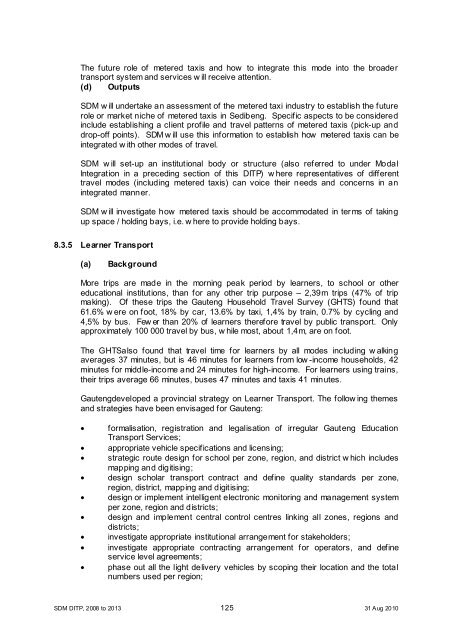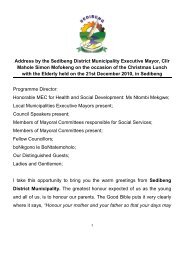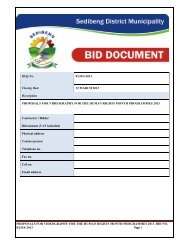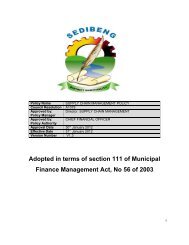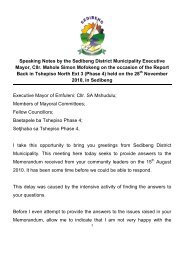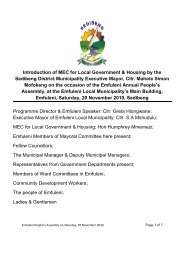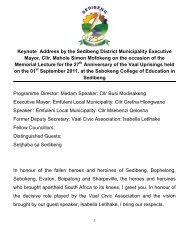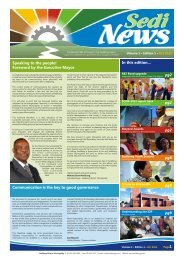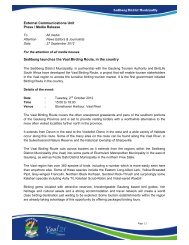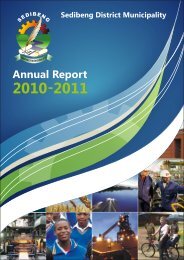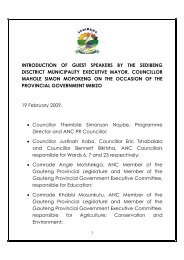Chapter 11 - Sedibeng District Municipality
Chapter 11 - Sedibeng District Municipality
Chapter 11 - Sedibeng District Municipality
Create successful ePaper yourself
Turn your PDF publications into a flip-book with our unique Google optimized e-Paper software.
The future role of metered taxis and how to integrate this mode into the broader<br />
transport system and services w ill receive attention.<br />
(d) Outputs<br />
SDM w ill undertake an assessment of the metered taxi industry to establish the future<br />
role or market niche of metered taxis in <strong>Sedibeng</strong>. Specific aspects to be considered<br />
include establishing a client profile and travel patterns of metered taxis (pick-up and<br />
drop-off points). SDM w ill use this information to establish how metered taxis can be<br />
integrated w ith other modes of travel.<br />
SDM w ill set-up an institutional body or structure (also referred to under Modal<br />
Integration in a preceding section of this DITP) w here representatives of different<br />
travel modes (including metered taxis) can voice their needs and concerns in an<br />
integrated manner.<br />
SDM w ill investigate how metered taxis should be accommodated in terms of taking<br />
up space / holding bays, i.e. w here to provide holding bays.<br />
8.3.5 Learner Transport<br />
(a)<br />
Background<br />
More trips are made in the morning peak period by learners, to school or other<br />
educational institutions, than for any other trip purpose – 2,39m trips (47% of trip<br />
making). Of these trips the Gauteng Household Travel Survey (GHTS) found that<br />
61.6% w ere on foot, 18% by car, 13.6% by taxi, 1,4% by train, 0.7% by cycling and<br />
4,5% by bus. Few er than 20% of learners therefore travel by public transport. Only<br />
approximately 100 000 travel by bus, w hile most, about 1,4m, are on foot.<br />
The GHTSalso found that travel time for learners by all modes including w alking<br />
averages 37 minutes, but is 46 minutes for learners from low -income households, 42<br />
minutes for middle-income and 24 minutes for high-income. For learners using trains,<br />
their trips average 66 minutes, buses 47 minutes and taxis 41 minutes.<br />
Gautengdeveloped a provincial strategy on Learner Transport. The follow ing themes<br />
and strategies have been envisaged for Gauteng:<br />
• formalisation, registration and legalisation of irregular Gauteng Education<br />
Transport Services;<br />
• appropriate vehicle specifications and licensing;<br />
• strategic route design for school per zone, region, and district w hich includes<br />
mapping and digitising;<br />
• design scholar transport contract and define quality standards per zone,<br />
region, district, mapping and digitising;<br />
• design or implement intelligent electronic monitoring and management system<br />
per zone, region and districts;<br />
• design and implement central control centres linking all zones, regions and<br />
districts;<br />
• investigate appropriate institutional arrangement for stakeholders;<br />
• investigate appropriate contracting arrangement for operators, and define<br />
service level agreements;<br />
• phase out all the light delivery vehicles by scoping their location and the total<br />
numbers used per region;<br />
SDM DITP, 2008 to 2013 125 31 Aug 2010


